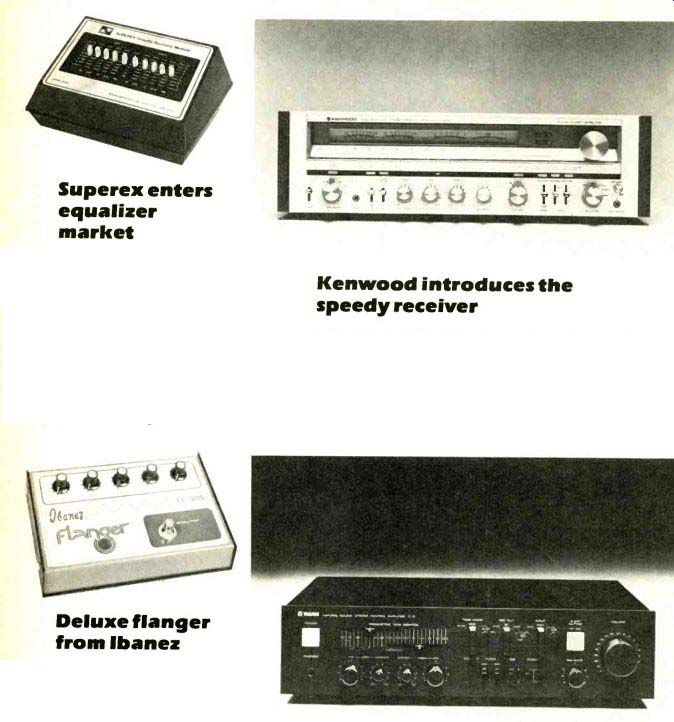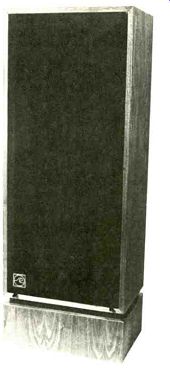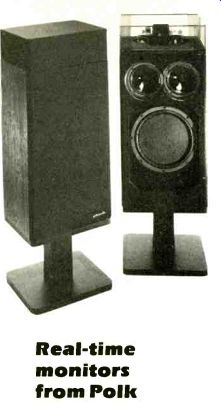New equipment, trends, and ideas for the home listener, recordist and musician.

Ace produces electronic crossover
Ace Audio's Model 6000 electronic crossover has its own power supply and offers a choice of fifteen standard crossover frequencies from 200 Hz to 10 kHz via plug-in modules with slopes of 12 dB per octave. Distortion is rated at 0.02%, noise at-90 dB. In kit form, the 6000 costs $92.25; wired, the price is $ 117.50. Custom frequency modules are available for $37.50, and any additional standard plug-in frequency module costs $27.50.
AGI preamp quick on the draw
A phono preamplifier designed for fast response has been introduced by Audio General. Claimed slew rate of the 511-A is 370 volts per microsecond, with a 0.01-microsecond rise time. A line amplifier is coupled with the phono section; according to AGI, 600-ohm loads may be driven without distortion. Price of the 511A, which also features a computer-compensated volume control, is $465.
Variable expansion from MXR
MXR's newest signal processor is the Dynamic Expander, providing up to 8 dB of upward expansion and 21 dB of downward expansion. A front-panel control allows variable release (approximately 50 to 500 milliseconds), and an LED display indicates the effect of the signal. Other controls include bypass switching and taping facilities. The Dynamic Expander costs $300; optional rack-mount ears are available.

Superex enters equalizer market
Superex' first equalizer is the GEM-1, a five-band (per channel) graphic design. A feature of the GEM-1 is its programmable EQ system, in which specific settings are contoured on cards that, when moved up the faceplate, automatically slide the controls into position. The tape-deck switching permits EQ in the recording circuit, EQ in playback, or straight tape monitor. The GEM-1 costs $89.95.
Deluxe flanger from Ibanez
The FL-305's analog decay circuitry achieves delay times between 0.8 and 16 milliseconds that, combined with the original signal, create true flanging effects. A WIDTH pot controls the frequency bandwidth to be flanged, DELAY LEVEL controls the blend of the flanging with the original signal, and REGEN feeds the flanged signal back to the input for a deeper effect. The FL-305 runs on two 9-volt cells, and a footswitch on the front panel engages or bypasses the flanger. Ibanez rates noise at-80 dBm and frequency response from 20 Hz to 20 kHz.Price of the FL-305 is $225.
Kenwood introduces the speedy receiver
Adopting circuitry formerly found only in Kenwood's high-end separates, the KR-8050 features a high-speed DC amplifier section and a pulse-count detector in the FM tuner. Power in the normal operation mode is rated at 120 watts (20 3/. dBW) into 4 or 8 ohms, 20 Hz to 20 kHz, with no more than 0.02% THD; a power boost switch raises the capability to 150 watts (21 3/4 dBW) into 8 ohms without exceeding the distortion spec. The tuner circuitry is credited with exceptionally low distortion and garnered a Grand Prix at a recent Japan Audio Fair.
A different twist in preamps
A servo control circuit in Yamaha's C-6 preamplifier is said to make possible the incorporation of a parametric tone control that allows user selection of center frequency, frequency bandwidth, and sound level. The bandwidth controls are continuously variable from narrow to wide; the level control has a ±12-dB range. The seventeen selectable center frequencies range from 31.5 to 640 Hz in the low band, and 640 Hz to 12.5 kHz in the high band. The C-6, which also contains a moving-coil head amp, costs $450.

A new star on the speaker horizon
The Nova RF-5R speaker from Manhattan Pacific uses a ribbon tweeter that handles the frequency range from 6 to more than 40 kHz. The other drivers in the vertical-array design are a 1 3/4-inch dome midrange and 1 2-inch woofer.
Continuously variable controls are provided for the midrange and high frequencies. Sensitivity is rated at greater than 90 dB SPL at 1 meter for a 0-dBW input. A time-phase compensated filter network is employed in the RF-5R, which costs $489. The speaker is also available with a 1-inch dome tweeter (as Model RF-5) for $439.
Esoteric develops stylus-cleaning system
Esoteric Audio, a division of Brahma Research, has introduced Stylus Formula, a cleaning system designed to rid styli of vinyl debris and polymers. SF6, which contains no alcohol, comes with an extension spray tube to prevent shaky hands from damaging stylus assemblies.
No pad or brush is needed, and a cap catches excess fluid. You can get six ounces of Stylus Formula for $6.00.
For Quadriphiles
A gentleman by the name of Larry Clifton has undertaken no less a task than a complete compilation of all quadriphonic recordings ever offered. His company, Quad, Inc. ( P.O. Box 19, Capron, Va. 23829), publishes a catalog, a quarterly, and a monthly newsletter. We've seen the catalog and are impressed with the obvious care exercised in its preparation. There are notes about announced (possibly not yet released) recordings, issue and withdrawal dates, and so on, that will fascinate collectors sharing Clifton's interest in quadriphonics. Perhaps when the bible of the quadriphonic era (which, we hope, has a future) comes to be written, these works will constitute the Pentateuch; in the meantime, they are full of interesting Numbers.
Lauderdale products preserve records
Two items from Lauderdale Electronic Labs join the legion of record-care products on the market. Its RC-32 Record Cleaner and De-Ionizer combines antistatic properties with a grime-removing solution. The company's RP-32 Record Preservative adds a 1-micrometer layer of dry lubricant to discs to slow down vinyl wear. Both products come in 32-ounce containers with "squirt-gun" applicator caps, at prices of $7.60 for RC-32 and $1 6 for RP-32.
Two-way headset from Sonic International
Sonic International's Pro-90 headphone uses individual woofers and tweeters in each ear cup, making it a two-way system with crossover at 3.5 kHz.
Rated frequency response is 20 Hz to 22 kHz; 1-kHz sensitivity is said to be 105 dB SPL from 1 milliwatt; recommended drive impedance range is 4-32 ohms. The Pro-90 weighs 9.7 ounces, has a 10-inch straight cord, comes with padded leather ear cushions, and costs $65.95.
McIntosh goes into energy saving
Frank McIntosh, founder of McIntosh Laboratories (the Big Mac of high fidelity, so to speak), now is head of a group called Energy Trust, based in Arizona. It is working on a joint energy project involving the TAF valve for gasoline engines, developed by Sumari Engineering, Inc. The valve, whose worldwide manufacturing and distribution rights have been purchased by Energy Trust, is said to increase gasoline mileage by an average of more than 20% (and up to 60% in some cases), improve performance, and eliminate hydrocarbon emissions in standard, carbureted internal combustion engines.
Superscope's super Pianocorder 'rolls'
Superscope has issued a catalog of "piano rolls" for its Pianocorder system, and it's an astonishing list. Equipped with the Superscope device and tapes from the catalog, your own piano can be played by the likes of Debussy, Rachmaninoff, Paderewski, Loesser, Grainger, Hofmann, Dohnányi, Gieseking, Busoni, and Rubinstein. The pianists and repertoire seem endless as we thumb through the forty six pages of listings. While we are (naturally) most impressed with the classics, there is plenty of popular music, too-tinkly favorites from waltzes to ragtime to Cole Porter and performances by such jazz greats as Earl Hines, James P. Johnson, Eubie Blake, and Jelly Roll Morton.
Fender's 12 -channel mixer
Fender continues to expand its line of mixing consoles with the new M- 12 portable, designed for sound reinforcement as well as recording. The M-12's twelve input modules each have high - and low -impedance inputs, four output masters, an array of effects -patching jacks on the back panel, a five -band equalizer, and SEND pots for three monitor channels and one cue channel. Two submaster modules are provided for grouping multiple inputs from drums or keyboards, and each master has its own built-in fast-at- tack/slow-decay limiter with threshold control and indicator LED. The M-12, which weighs 65 pounds and measures 31 by 27 by 7 inches, costs $3,100.

Real-time monitors from Polk
Polk Audio's Real -Time Array monitor loudspeaker, the RTA-12, was in- tended to combine the qualities of studio speakers with state-of-the-art technology. The system employs an acoustic crossover between the molded -foam subwoofer and the two midrange drivers as well as a computer -designed electrical network between the midrange and the dome tweeter. Rated frequency response is 27 Hz to 20.5 kHz, ± 2 dB; recommended power is 10 to 500 watts (10 to 27 dBW). The RTA- 12 costs $350
Feedback phase shifter
The Phase Tone PT -909 has all the features of the traditional foot-pedal phase shifter but contains some extras. A feedback pot routes the output of the phaser circuit to the input for a deeper phase sound. The PT -909 also includes a low -frequency oscillator for modulating the input signal and creating more dramatic effects, and a heavy-duty foot - switch can bypass the effects. Connections are standard phone jacks; controls include FEEDBACK, SPEED, and WIDTH. Cost of the PT -909 is $99.
Road-safety system from Blaupunkt
Already in use on German Autobahns, a broadcast-based highway- safety/traffic-control system developed by Blaupunkt may someday find its way onto American highways. The system operates this way: In each section of Ger- many one FM station carries a sideband signal that is always on, albeit without a program. At any time, the FM broad- caster can air a warning of accidents or poor road conditions, or suggest alternate routes to avoid a bottleneck. When the sideband signal starts to carry pro- gram information, a specially designed tuner switches automatically from regular reception. The signal can even turn on a tuner that's off, override a cassette, and turn up the volume so that you can't miss the warning. Blaupunkt is the major sup- plier of tuners and receivers so equipped.
On certain models of its Berlin receiver, the warnings are visual as well as aural--a gooseneck display lights up to show accident, fog, road blockage, or other road problems.
Blaupunkt's engineers hasten to admit that road and broadcast conditions in the U.S. are markedly different from those in Germany. For one thing, thou- sands of miles of interstates are outside the range of any FM station, while a handful of transmitters are adequate to blanket all of Germany. In American urban areas, as many as forty FM stations can compete for listeners, complicating the problem of automatic retuning. In Germany, a tuner needs to cope with fewer than half a dozen signals at a time; only one government -operated station in each area carries the coded signal. But Blaupunkt contends that the system is ex- portable and suggests that the next move is up to U.S. government officials.
HF
(High Fidelity, Oct. 1979)
Also see:
Jensen speakers (ad, May 1981)